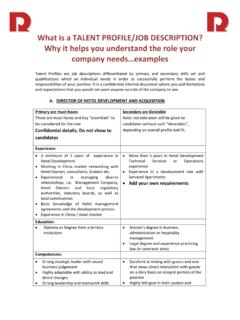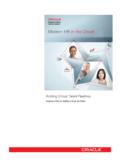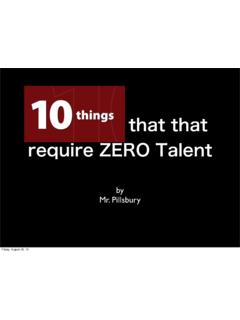Transcription of The Age of Human Potential—Talent Management
1 The Age of Human potential talent Management William A. Guillory, President Innovations International, Inc. Salt Lake City, Utah 84117 talent Management is an expression of the Age of Human potential . talent Management refers to sourcing, recruiting, developing, empowering, advancing, and leveraging the potential of the naturally existing diverse Human talent available. The evolution of the Human potential movement is shown by the succession of Global Business (and Societal) Paradigms over time.
2 As indicated, we are presently on the leading edge of the Human potential Paradigm. The basic assumptions or universal laws of this paradigm with respect to business or organizational success are listed below. Basic Assumptions (Universal Laws) of the Human potential Paradigm 1. The quality of a product or service is synonymous with the mind-set of quality of the individual(s) who produce or deliver it; for example zero-defect thinking and performing produces the highest quality 2. The efficiency and effectiveness of operation of a product or service is synonymous with the functioning of the organization that produces it; for example, an organization which maximizes performance by combining a highly empowered Management system with highly competent employees.
3 3. The ultimate success of a product or service is synonymous with how successfully an organization or unit (project team) operates in terms of professional, interpersonal, technical, and cultural compatibility: external success is a reflection of internal success; the two are inseparable. 4. The ultimate objective of an organization is to create an environment of expectation for personal and professional growth and continuous higher-order creative exploration which in turn creates the next generation product or service. 5. The achievement of an environment of expectation for growth results in the creation of a cadre of quantum-thinkers (futurists, visionaries, and strategic thinkers), who are capable of predicting succeeding global business and societal paradigms.
4 These assumptions are founded on the balanced utilization of individualism and group orientation in achieving exceptional performance; where collaboration is assumed to be the dominant mode of operation. The Vision of talent Management The vision of talent Management is to achieve a goal and an objective. The goal is to create a specific percentage of higher-functioning individuals where his or her potential approaches maximum performance. The objective is to create a permanent environment (culture) where higher-functioning individuals continually learn, flourish, and grow. For example, exceptional performance requires both a higher-functioning individual as well as an environment that demands, supports, and celebrates such performance.
5 This level of performance is simply not possible where there is the dominance of control Management , hierarchy, and an environment of fear of risk-taking. The latter practices are particularly counterproductive during difficult times even though the opposite of these three practices might appear to be counter-intuitive. The key is strategic choice-making and aggressive implementation. The slogan of the Lexus Division of the Toyota Motor Corporation for years has been The relentless pursuit of perfection. This slogan has been recently changed to We pursue perfection, so you can pursue living. These slogans are comparable to a vision statement.
6 They are also vision statements that are pursuing an objective that cannot be achieved, because perfection continually changes to a higher level of performance, products, and service as it is being pursued!. The net result is slogan-driven continuous improvement of performance, products, and services. Diverse Human talent Setting aside the question of the advantages of diverse Human talent , the fact is that the talent available is humanly, culturally, and operationally diverse both locally and globally. The only question is how do we uniquely develop and synergize such diverse talent .
7 This question combines both diversity and Human dynamics. The key here is to use inevitable conflict resulting from differences as opportunities to sling-shot performance to an exceptional level. This assertion is based upon the assumption that the greater the barrier differences and emotional energy associated with conflict, the greater the Human transformation and correspondingly, the potential for exceptional performance. There have been numerous studies that show that diverse teams, perspectives, and ways of operating lead to more powerful results compared to homogeneous teams; but, only after such diverse team members go through their rite of passage.
8 This rite of passage involves personal and collective transformation of the individuals involved commonly experienced during diversity-related trainings or facilitated workplace conflicts. Several years ago I facilitated a train-the-trainer program for a Fortune 100 Corporation. There were four trainees a black male, a black female, a white female, and a Hispanic male. One of the skills necessary for certification is mastery of facilitation. I decided to develop this skill using a team consensus process integrating the ideas of all four trainees. The half-day exercise resulted in conflict, frustration, and ultimately individual and team humility which was the experience I was attempting to achieve.
9 It is giving up one s individual idea such that it disappears into a much more powerful group idea. Achieving consensus is significantly more transformational than a simple democratic vote where collaboration is concerned. talent Management Competencies The competencies required for the Human potential Age can be categorized as cognitive, behavioral, and strategic. The most important distinction to be made is that behavioral skills can be taught by behavioral modification or learning whereas both cognitive and strategic skills can only be mentored, coached, or facilitated. The latter skills involve guidance, feedback, and transformation.
10 Cognitive skills are those involving a predisposition to behavior or mind-set. These include responsibility, accountability, dedication, commitment, sensitivity, persistence, awareness, desire, determination, creativity, innovation, and quantum-thinking. These skills are learned from childhood and strongly influenced by parental guidance. In the workplace, these skills are facilitated by stretch projects, case study exercises, and most of all organizational cultural influences. Behavioral skills are the easiest to teach and learn because they do not directly involve a transformation in mind-set.






